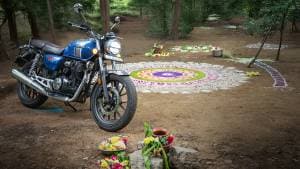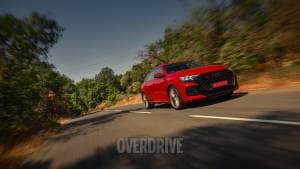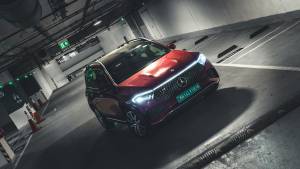Independence Day - The road well travelled
Our independence, nearly 60 years after the fact remains the biggest transformative change our country has seen in the last two hundred years. This patriotic discussion eventually turned back to cars and motorcycles as is our lot at OVERDRIVE. How were the roads then? How was driving back then? Whats changed over the decades? And so on and so forth. So we went out to find people who were actually driving before India became Indian. Not an easy task mind you, since we had to be looking for people who were more than 83 or 86 years old.
We found three amazing stories that will blow your socks off!
Nariman Contractor
March 8, 1948 is a very long time ago. That was the date when Nariman Contractor got his driver's license. However he'd already been driving a fair bit as he'd learnt the art
in a 1929 Austin when he was studying to be an automobile engineer in Surat. Contractor is 89 today and over the past 64 years he's seen India evolve from a place where precious few had the privilege of driving to a country that produces the most affordable car in the world.
His very first vehicle was a 1938 AJS motorcycle. Nariman or Nari, as he's affectionately called recalled that the AJS was bought during the days of petrol rationing. His family used to get four coupons worth four gallons each (a bit over 16 litres) for an entire month. With the bike he didn't need all that fuel and used to sell the coupons off to make some pocket money. He chuckles at that statement and says that he was a pukka businessman from the very beginning. His first car was a V8 Ford that he used to run as a taxi in Mumbai city. He then gave the car to his brother after three years when he joined the RTO. Working in the RTO meant he saw everything from princely Rolls-Royces to stately Mercs and also plenty of oddities including a steam engine truck that was used at the Mazgaon docks! He also remembered his second car, an Adler that had the amusing peculiarity of repeatedly losing its front right wheel.
When I asked him about what it was like driving back in the old days he remembered the time he and his friends jumped into one of their Oldsmobiles and went on an epic journey from Mumbai to Kashmir. In today's day and age it's still a long and arduous drive, I can barely imagine what it was like doing it back then. While the roads back then were narrow they very much existed. The difference was that there was next to no traffic on them. By the time they were close to Agra the car broke down thanks to a failed engine bearing. Stranded and with no idea what to do they were approached by a Sardar who was driving a truck. He insisted on staying with them till another one of his other trucks arrived and towed them to Agra. There he arranged for a local mechanic to give them all the assistance they needed and then refused to take any money for the same. It was this willingness to selflessly help another motorist that Nariman Contractor feels is missing in today's scenario.
Surprisingly enough he says that even in the early years of post independence there was a sense of lawlessness on the road. The rules definitely existed but no one really paid them much attention. The difference of course was the tiny numbers of cars on the road which meant it wasn't much of a problem at all. "Driving was always in my blood. I always enjoyed driving, but if I had to choose an era I think the sixties were my favourite". The roads were good, so were the cars and there was very little traffic. Regarding the cars, Nariman says it would have to be the Morris 8. He had the car for three years and it's always been his favourite. He recently spent some time driving in New Zealand but says he'd still rather be driving his old Morris rather than the Honda he was using. "It was a simple car, no complications, an engineer's car"
However he's not averse to progress. He was very happy with the launch of the 800 back in 1984, so much so that he ended up eventually buying one. Over the years he also owned three bikes, the AJS, a twin cylinder Triumph and a Norton single. The Norton was an army spec bike that came with a sidecar. Nari remembers how you had to be careful while kickstarting the bike if you didn't want a broken leg. Today it's just a matter of pushing a button. Modern bikes have come a long way in a good way.
After over 30 years in the RTO Nariman left under voluntary retirement and went into the bus business. Despite having no experience in the field whatsoever he bought a rickety old Tata bus from Vellore, repaired it and started off. The business man in him was finally given a free reign and by the time he retired a few decades later he had over seventy buses on the road. Through all the years he was a loyal Tata customer and the family even uses a Manza today.
While recounting all these moments Nari suddenly says its bizarre that so much in his life has gone by. And I think to myself that I'm lucky to have heard some of the stories. And hope that when I'm old and wise, I'd have the same sparkle in my eyes, that my age would be marked by a similar anecdotal kaleidoscope of experiences at the wheel and in the saddle. That would be the life, wouldn't it?
Pheroze Cama
Few people are as qualified as Pheroze Cama to talk about the evolution of motoring in India. He's watched the story unfold since the 1930s and continues to do so today. You see, Cama still drives from Mumbai to Pune himself, which completely boggles the mind when you consider that he's going to be 92 in a couple of months.
The only person who let Pheroze drive when he was an adolescent was his grandmother and he ended up learning to drive in her French made Minerva. He got his license in 1940 and his first vehicle was a two seat Ford Model A. He was very fond of cars from the very beginning and started off by helping a few friends repair their cars. That gradually grew into him opening his first garage. He named it the Modern Paint and Auto Corporation and specialised in paint work, denting and upholstery. After shifting shop a couple of times he settled down at what was once a horse stable at Worli with a workshop that could handle 21 cars at a time. He used to work with both Indian and imported cars and had his fair share of big clients. Ratan Tata and his younger brother Jimmy were regulars at the garage. Pheroze fondly recollected how Jimmy had bought himself a Japanese Jonga and had big plans for customising the car with leather and rose wood among other things and insisted that all the work be done solely at his garage. He sold the business after 32 long years and today the same space is a service centre for a major luxury brand.
So what was it like driving under the British raj and then um, under freedom, so to speak? Pheroze says there was definitely discipline driving back then. There was respect and even fear for authorities. However he says that corruption was always around. Even in those days you could get away with a small offense but today it is far too open and blatant. The corruption levels have really skyrocketed. After the British left the discipline continued for a short time before we started to head towards where we are today. As for when was his favourite motoring era; "I enjoyed driving in the late thirties and early forties. The cars were pretty special as well. I had bought myself an eight cylinder Bugatti back then. It was from the British manager of the showroom for Hillman and Humber cars. The Bugatti was leather bodied (leather wrapped doors) and came with a canvas roof. The manager used his showrooms workshop to convert it into a two seater and removed the doors. The rear was also modified into a tapered end. Even the windshield was a two piece unit (like on the new Galibier). When he was leaving India I offered to buy it at a reasonable price and after some back and forth we settled on 1900 rupees. I even took a loan from my grandmother to buy it but it was very much worth it. This was sometime in the forties. It was very unique but then again in those days most cars were made to order, at a price of course."
He also owned an Armstrong Siddeley and an American Hudson. The two seater 8-cylinder Hudson Terraplane had a radio. Back then a radio in a car was just unheard of in those days. He bought the car for just 950 rupees. With its radio the car attracted so much attention that when he eventually sold it he managed to get 1500 rupees for it. And that was all because of the radio. He almost always owned one car at a time and used to change cars very often. He says he's easily gone through about 25 to 30 cars in his years. Cama always felt the old cars were better looking and better to drive. But it's difficult to keep them maintained and you need to import parts for them and all. However at his age, for the last six or seven years any car he buys must have two things-an automatic transmission and ABS brakes.
Two wheelers? "Don't talk about motorcycles. When I was young I had an argument with a friend that led to a bet that I could jump a motorcycle off a ramp over two and a half feet high. I had an actor friend named Bilamoria who had a BSA. I took his motorcycle, built a ramp and went for it. It turns out I was too fast and I went straight to hospital with a broken shoulder" He was never very into motorcycles after that.
What does Pheroze Cama think about driving today? The fact that he has hired a driver to take over once the expressway is over and Mumbai begins should give you the answer. As I write this I'm completely overcome by a wave of awe at Pheroze Cama's story. What an incredible life he's led, It's what every enthusiast aspires to.
Hema Gupta (Amit Dwivedi's godmother)
I have two mothers. One that gave birth to me and one that taught me the art of living. Not the philosophy, the actual art of living life. You might think this is too deep for an automag but it has a profound relationship to what's coming further ahead in this story.
The story begins in the days when I was still learning how to drive cars. Hema Gupta, my godmother, who was 78 then was my tutor. I was trying to park my car in the apartment block one day and I just couldn't parallel park. After a while, my godmother said, "Okay, get off the driver's seat and watch. I will show you how to parallel park in one move." She turned the steering wheel, gave it some light throttle, reversed into the slot, turned the wheel the other way and smoothly parked the car neatly in its slot all while I watched in awe. I was astounded how such an aged lady managed so well and so I asked her how long she had been driving. She quietly told me her story, in her words...
"When I was 17, my father bought his first car, a Dodge. I first got behind the wheel in 1946 when I started to learn to drive. I was married and my husband was a modern man and a lover of automobiles who encouraged me to drive. So my relationship with cars is nearly as long as my life itself. I remember when my father would drive us from Bijnor to Rishikesh for a holiday and we would see barely five-six cars on the whole trip. Back then very few people had cars and everyone would stop to watch our car go by, just as it happens with Bollywood stars today.
At that time, petrol was five-six annas (about 35 paise) a litre. Fuel prices and economy was the last thing on anyone's mind. Then my husband bought a Chevrolet and that became the second car I drove. We used to drive that car for about a 100km every day. For many years, my husband was stationed in Mumbai and to be honest, that is where I really enjoyed driving. Many weekends were spend in Kasara, or Lonavla or even Mahabaleshwar - we drove everywhere and every drive was a memorable one. We had a series of cars by this time, Opel Kadetts, Opel Convertibles, HM's Ambassador and the trusty Maruti 800.
Today I drive a 1995 Maruti Suzuki Zen. In fact, I've driven cars without power steering for so long that when I recently drove my husband's Honda Civic, I didn't like the feeling of the steering at all. But technology is not what has changed cars for me, traffic has. Before independence and up to about 25 years after that, India had very little traffic. The roads were empty and cars were very, very few.
I completed all of my education after marriage and I remember that in the 60s, I lived in Delhi but studied in Meerut. I would drive my Ambassador to go to college and it would take me an hour and a half to cover the distance. Today that is simply not possible. In today's world, I find it baffling that before we became independent we didn't have that many cars, or great roads. Now that we are an independent nation, we have so many roads, so many cars and it has come to the point where we cannot drive them without worry, tension or stress. The fun in driving that I used to experience seems to have evaporated.
As I listen to my godmother regale me with the amazing tale, her wistful look was similar to one of those former racers recounting their days of high speed and glory over a quiet cup of coffee held in wrinkled fingers.
Starts Rs 17.94 Lakhs
1597cc
Manual
120
300
26.8 Kmpl











